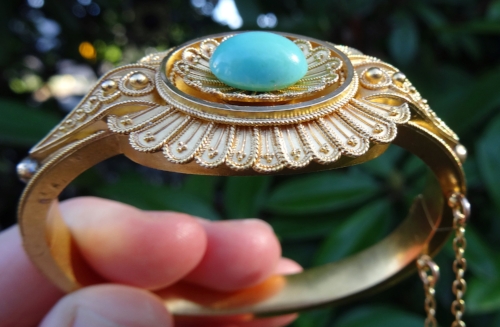The Etruscan Revival was sparked by 19th century archaeological digs in the Etruscan ruins of Italy. An Italian jeweler by the name Fortunato Pio Castellani is credited with the rediscovery of the Etruscan gold working technique. He created amazing replicas of the ancient jewelry excavated from Greek and Italian ruins, and passed on his knowledge to his son, Pio Castellani. Their influence spread throughout Europe and America, gaining popularity in the 1860's and 1870's. Etruscan Revival jewelry is characterized by applied beading and filigree, specialized woven and rope motifs, and granulated surface effects. These pieces are made from 14 karat yellow gold, using a special technique to bond higher karat gold to the surface with mercury. This era of jewelry is unmistakable, and its beauty awe inspiring.
When we happened upon this bracelet, it was covered in who knows what! Thankfully, Joe was able to restore this piece to its former glory. The turquoise may or may not be original to the bracelet (it's hard to tell), but the piece itself is authentic, and in remarkably good condition!
We believe this particular piece to be American-made, as European pieces from this movement were generally hallmarked.
Now that's something you don't see every day!
Note the organic, asymmetrical nature of the metalwork.
Stunning from every angle.
Can I keep it? lol
The Etruscan revival was one of several revival movements during the 19th century, which lost ground to modern styles introduced in the Aesthetic and Arts & Crafts periods of the late 1800's and early 1900's. This style of jewelry making has died out, but the pieces live on!
This bracelet is for sale for $2,900. Please note this would be best suited for an individual with a small wrist. Regardless of what you're in the market for, I'd recommend people come take a look while they can. We've rarely come across pieces like this in person, and it is just a thing of beauty.



